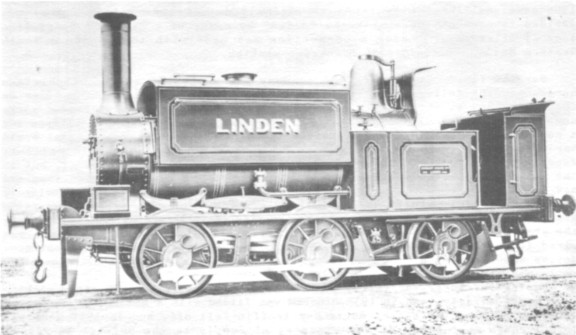
| THE INDUSTRIAL RAILWAY RECORD |
© NOVEMBER 1962 |
HUNSLET No. 1
By GEOFF HORSMAN
Hunslet's first locomotive, LINDEN, left their works in Jack Lane, Leeds, for Ampthill, Bedford, on 18th July 1865. The purchasers were Brassey and Ballard who, three months previously, had secured the contract for the construction of the section between Bedford and Aldenham (Elstree) of the main line of the Midland Railway.
The Hunslet Engine Company was founded in 1864 and the design of Engine No.1 appears to have been started in June of that year. Drawings for the locomotive, as well as drawings of equipment and tools for the new shops, were turned out at intervals until the following Spring.
The works photograph reproduced shows LINDEN as built, the design being typical of contractors’ locomotives of the day. Points of interest are the flat smokebox door, built-up chimney, compensated spring gear, and brake gear which was hand operated and applied wooden blocks to the driving and trailing coupled wheels only. The straight sandpipes discharged sand on to the rails some distance ahead of the wheels - a feature which was later remedied.
Angle irons riveted to the top of the motion plate, which extended above the top of the frames, formed a saddle which gave additional support, but not rigid attachment, for the boiler barrel. The plate also carried the compensating beam brackets. The coupled wheel centres were of cast iron with spokes of oval cross—section, cast hollow. A long stroke pump secured to the inside of the right hand frame and driven from the right crosshead, provided the boiler feed, as did an injector, the top of which being just visible in the photograph behind the left hand fence plate.
The firebox back, besides carrying the regulator handle and stuffing box, had an unprotected water gauge on the left and two try cocks on the right hand side. A sliding two part firedoor completed the fittings. The weather— screen carried a pressure gauge on the left side, and the graduated scales of the safety valve spring balances were visible through a glazed porthole in the centre of the screen. On top of the firebox were the injector steam valve, steam jet valve, whistle and pressure gauge cock. The usual ashpan damper gear, cylinder cock gear, sand gear and injector water cock control were provided on the footplate.
Whilst quite a lot is known of the construction of LINDEN, few of its movements have been recorded, although a later owner was J.P. Edwards, another railway contractor. A new boiler and smokebox (the latter again with a flat door) were supplied at the end of 1878 or early in 1879. At the same time the spring gear compensating beams were removed. The compensated spring gear was a feature of many early locomotives which, whilst distributing the shocks produced by the uneven track between the axles and not directly to the frames, had the disadvantage of allowing the locomotive, especially a saddle tank type, to roll badly when travelling at anything above very low speeds over indifferent track.
During 1888 No. 1 again returned to Hunslet for another new boiler and smokebox. This time the smokebox door was of the circular dished pattern. New cylinders of 14½” diameter were also fitted, and No.1 was tried in steam on 16th November 1888. Now named PATRICROFT her owner was T.A. Walker who is believed to have used her on the Manchester Ship Canal works.
About a year later the sand gear was altered and the ends of the sand-pipes were brought much nearer to the wheels. New cast iron leading sand-boxes which formed half the leading wheel splashers were fitted, the rear half of each leading splasher being bolted up to then. During 1890 a set of rail washing gear which drew its supply of water from the saddle tank was provided. A new set of wheels and crankpins followed in 1891. The wheel centres were again of cast iron, but with solid rectangular cross-section spokes.
Engine No.1 was last heard of in May 1902 when four bearing spring top plates were ordered. By this tine it had been renamed NOTTINGHAM and was owned by Sir John Jackson Ltd., Contractors.
Brief dimensions (when new) are as under:-
| Gauge | 4' 8½" | Heating Surface (Tubes) | 664 sq. ft. |
| Cylinders | 14" x 18" | Heating Surface (Firebox) | 61 sq. ft. |
| Coupled Wheels | 3' 4" diameter | Heating Surface (Total) | 725 sq. ft. |
| Wheelbase | 12' 0" | Grate Area | 10 sq. ft. |
(Further information on other owners, and in particular the contracts on which No. 1 worked, would be welcomed, as also would details of her final disposal. The photograph is reproduced by courtesy of the Hunslet Engine Co. Ltd. – Ed.)